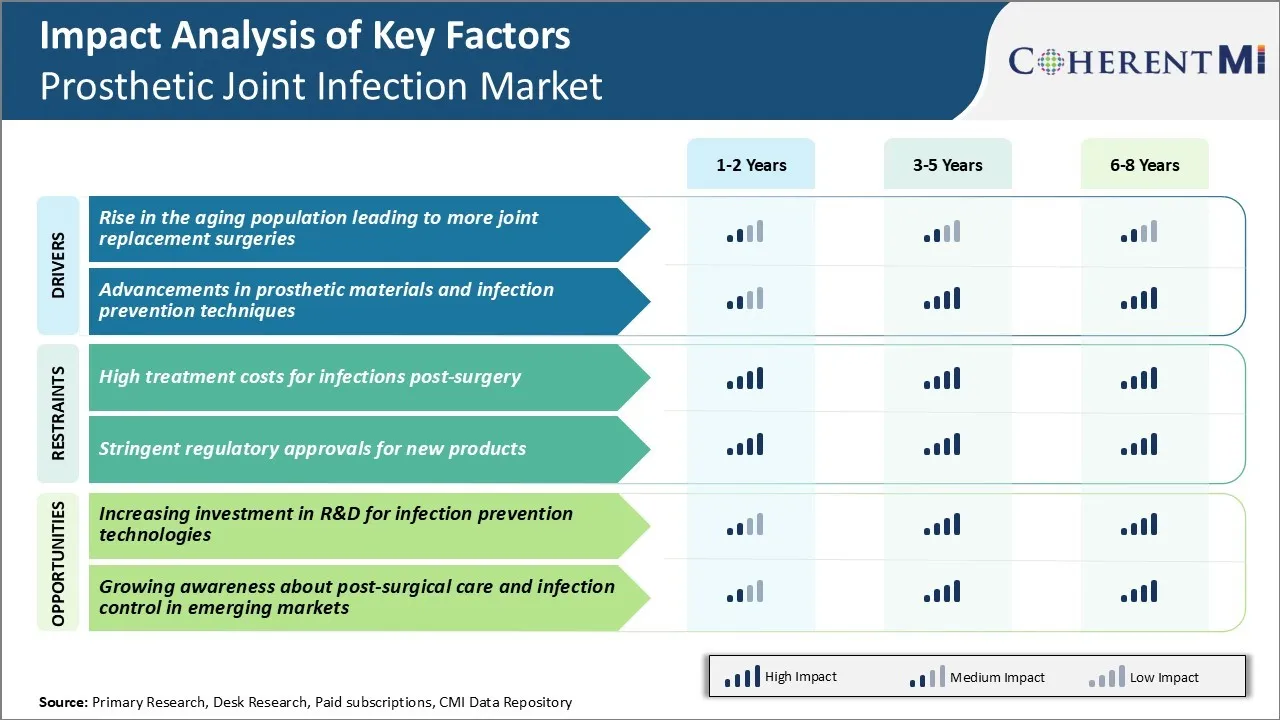Prosthetic Joint Infection Market Trends
Market Driver - Rise in the Aging Population Leading to More Joint Replacement Surgeries
For many aging individuals, joint disorders have progressed to an advanced stage where conservative treatments such as medication and physical therapy do not provide adequate relief anymore. This makes surgery the most viable option to get back the flexibility and improve quality of life, making it a growth prospect of growth for prosthetic joint infection market.
While joint replacement procedures have a high success rate of alleviating symptoms, the surgical site is always at risk of potential infections in the post-operative period. Elderly patients are additionally vulnerable as age-related factors can decrease the body's ability to fight infections. Even minor surgical site contaminations may progress into full-blown joint infections in these high-risk cases.
Therefore, as the percentage of senior citizens undergoing knee and hip replacements rises, it will continue to drive growth of the prosthetic joint infection market.
Market Driver - Advancements in Prosthetic Materials and Infection Prevention Techniques
Over the last decade, major technological advancements have been made in the field of orthopedic joint replacement implants as well as infection control practices adopted in operating rooms. Newly developed biomaterials used for producing prosthetic components offer better biocompatibility and resistance to bacterial biofilm formation compared to earlier generation implants.
On the other hand, strict adherence to evidence-based infection prophylaxis protocols during surgery has significantly lowered the rates of surgical site contamination. Application of antibiotic cement spacers also helps eliminate infection in already infected joints prior to revision procedures.
However, as some of these new interventions are still being validated through long-term data, prosthetic joint infections will remain an ongoing concern. Overall, innovations in biomaterials and safety protocols have opened up new possibilities in the prosthetic joint infection market for improved patient outcomes but also contribute to the persistent need for effective anti-infective therapies.

Market Challenge - High Treatment Costs for Infections Post-surgery
One of the key challenges faced by the prosthetic joint infection market is the high costs associated with treating infections that occur post-surgery. Prosthetic joint infections, such as those in hips and knees, can develop months or even years after the initial implantation procedure.
The average cost of treating a single case of prosthetic joint infection in the US is estimated to be over $50,000. This does not even account for lost work and wage costs for the patient. The financial burden is even higher for infections that are difficult to eradicate and require multiple surgical revisions and long antibiotic therapy.
As the number of joint replacement surgeries rise, especially among younger and more active individuals, the risk and incidence of infections is also increasing. This will significantly drive up the overall healthcare costs related to prosthetic joint infections. Unless new preventive and therapeutic solutions are discovered, treatment expenditures are projected to grow rapidly.
Market Opportunity - Increasing Investment in R&D for Infection Prevention Technologies
One promising opportunity for the prosthetic joint infection market lies in the rising investments and R&D activities focused on developing advanced infection prevention technologies. Companies and research institutes are investing more resources in areas such as antibiotic-eluting implants and biocompatible coatings that reduce bacterial adhesion.
For instance, there is ongoing research on coating joint implants with silver, antibiotics or host-defense peptides to prevent bacteria from latching on to the implant surface. Development of novel implant surfaces that stimulate soft tissue integration and wound healing can also aid infection prevention post-surgery.
With the projection of increasing rates of joint replacement procedures globally, vendors stand to gain significantly by introducing novel solutions that help lower infection risks and drive better patient outcomes. This will not only improve quality of life for patients but also help control escalating annual infection treatment costs.